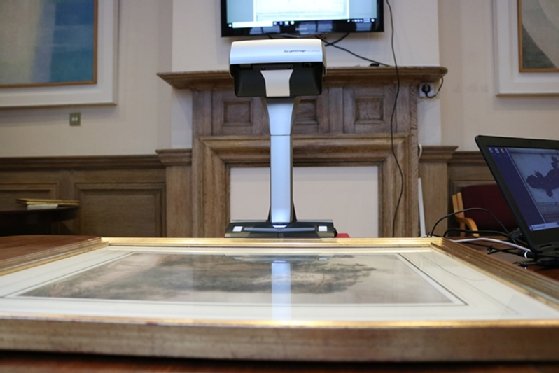
Watercolour World digitises ‘photographs’ of the pre-camera age
Charity dedicated to making thousands of fragile pre-1900 watercolour paintings available on the web has launched its site with help from Fujitsu scanner maker PFU
The Watercolour World, a charity focused on making watercolour paintings available more widely on the web, has launched its own website.
Thousands of watercolours are locked or hidden away in museums and private collections. They outnumber oil paintings many times over, and they are more fragile. Their colours would quickly fade in light.
They are also the “photographs” of the pre-1900 world. You could knock off a watercolour much more quickly than an oil painting, and do so in a sketch-book on your lap. They thus convey a picture of what life was like before the age of mechanical reproduction – of photographs.
Andra Fitzherbert, chief executive officer of The Watercolour World, says: “Watercolours are the poor relation of oil paintings. They are often hidden away. They are by nature more fragile, more ephemeral, more affected by heat and light. Also, the watercolours we are digitising are drawn from both public and private collections.
“We were founded to document these important paintings and aggregate them on a geolocated website before they are lost for ever.”
The charity has teamed up with PFU, a Fujitsu company that manufactures scanners, to digitise and document paintings onto a single geographically indexed and fully searchable library.
The Watercolour World’s small team has been using PFU’s ScanSnap SV600 to do the job, taking it on trips to country houses, provincial British museums and the like, scanning watercolours from public and private collections.
So far, the online, free-to-access archive has about 80,000 watercolours spanning 18,000 locations, many of which have been digitised using the ScanSnap SV600, which can scan images through glass, so paintings don’t need to be removed from their frames, avoiding the risk of damage.
Fitzherbert said about a quarter of the images are from the UK, but it is a global project.

According to PFU, the scanner has a light range that is powerful enough to capture the images in high detail and is within safe limits for the watercolour medium, so will not harm the delicate paint.
The charity’s project is a development of an initiative founded by Fred Hohler, former diplomat turned art world impresario, who founded the Public Catalogue Foundation in 2002, which photographed and published more than 200,000 oil paintings in public ownership in the UK for the first time. Today it is called Art UK.
Fitzherbert added: “The online archive we have created, with the help of PFU, enables visitors to search and zoom into many documentary watercolours. Already this has helped the scientific community to identify changes in landscapes over time, and we are excited to see how the power of our digital age harnesses the information that can be found in historic watercolours.”
As examples of material that the project is newly bringing to light, Fitzherbert mentions paintings by soldiers travelling throughout the world in the heyday of the British Empire, or paintings of early flight, such as balloons being launched in the late 18th century.
“It is effectively the photography of its day, and it documents the known world before photography,” she said.
Fitzherbert’s colleague, Martin Oldham, head of production and research at the charity, gave one example of its team scanning 1,200 watercolours at the Dorset County Museum in a day. And he adduced the phenomenon of aristocrats on the Grand Tour, taking a watercolour artist with them to take what was effectively holiday snaps.
One such was the Yorkshire traveller, and a founder of the Travellers’ Club, JBS Morritt, who took an unknown Viennese painter with him to Turkey in 1794, where he produced a Plains of Troy scene that the Watercolour World team scanned, along with hundreds of other watercolours belonging to Morritt’s family. He also wrote a diary, which made it easier to locate the scenes, said Oldham.
“He was looking for where the Trojan war had taken place, and published a pamphlet that said that what Homer had written in The Iliad was archaeologically true,” he said. “He would have shown his holiday snaps to his friends, and used some of them in his pamphlet [A Vindication of Homer and of the Ancient Poets and Historians who have recorded the Siege and Fall of Troy (1798)].”
Read more about digitisation projects
- Digitising the BFI National Archive.
- New York Philharmonic puts Toscanini archive online for worldwide audience.
- Amnesty International creates human rights digital archive.
Mike Nelson, senior vice-president at PFU, said: “Watercolours have helped to create a visual record of the world before photography, providing vital information for historians and scientists.
“The SV600 was developed with the intention of helping users to transform their scanning experience and create accurate digital images. We are proud to be partnering The Watercolour World to help it digitise and record these paintings for posterity, enabling everyone to see what life was like before 1900.”
Steven Chad, customer engagement manager at PFU, added: “The concept [of the project] appealed to one of our principles, which is that we aim to take actions to benefit society, and enable the flow of the world’s knowledge.”
Fitzherbert said: “The start of the story was at the FitzWilliam museum in Cambridge, in a sense. Fred [Hohler] was in the museum and wanted to get a book of their paintings and they didn’t have one. That was what triggered him to say ‘these things should be accessible’.”
The Watercolour World is supported by the Marandi Foundation, a philanthropic organisation that supports educational, cultural and children’s health services. Joint patrons are the Prince of Wales and the Duchess of Cornwall.










